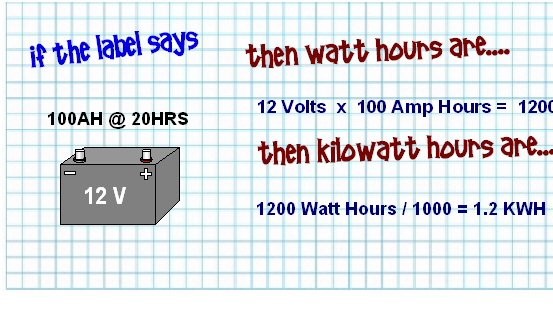
AMP HOURS VS KILOWATT HOURS
AMP HOURS VS KILOWATT HOURS
Amp Hour and Kilowatt Hour Differences Defined
Simply put, Amp Hours are a measure of electric current and Kilowatt Hours are a measure of electric power.
However, there is a relationship between the two. Specifically, electric current is a component of an equation that helps to determine electric power. That equation is…
Power in Watts = Current in Amps x Voltage
Consider the following…
A battery rated for 100 amp hours will provide 5 amps for 20 hours.
If we have a 12 volt battery, we multiply 100 by 12 and determine that the battery will provide 1200 watt hours.
To apply the metric ‘kilo’ prefix, we divide the result by 1000 and determine that the battery can supply the 1.2 KW hours.
There is something to keep in mind. The Amp Hour rating is a 20 Hour rating, therefore it is necessary to treat any kilowatt conversion you make as a 20 hour rating as well.
In the case of our 1200 Watt Hour conversion, we need to understand that what is really being said is that the battery will provide 60 Watt Hours for 20 Hours.
Notes on Kilowatt vs Watts, KW vs KWH
The prefix ‘kilo’ indicate one thousand. Think of it as a multiplier. For example, if we have 1 Kilovolt (KV), we have 1000 volts.
Similarly 1 kilowatt equals 1000 watts.
The standard abbreviation for kilowatt is KW.
This differs from kilowatt hours. The abbreviation for kilowatt hours is KWH.
Limitations on Kilowatt Hours as Tool.
Like Amp Hours, the Kilowatt Hour specification is a typically 20 hour rating. Like Amp Hours, the Kilowatt Hours are subject to a phenomenon known as Peukert’s Law.
What this phenomenon describes is the fact that any increase in the current draw on the battery will also result in a decrease on capacity. Similarly decreasing the current draw will result in an increase in battery capacity. More, the relationship is not linear.
From a practical perspective, this means the Kilowatt Hour rating is difficult to extrapolate when value as the current draw increases.
Kilowatt Hours and Series Batteries Systems.
In some systems, 12 volt batteries will be connected in series (end to end) to created a higher voltage. For example, two 12 volt batteries in series will provide 24 Volts.
Suppose two 12 volt batteries rated at 100 Amp Hours were connected in series. While the voltage would increase to 24 Volts, the Amp Hours would remain the same.
While amp hours remain the same, voltage does not. That means the power capacity has increased.
In the case of our 100 Amp Hour series batteries, the Watt Hours have increased to 2400 watts.
This particular characteristic can be a contributor to choosing 24 Volt Systems.
Wire size selection is largely based on the current that the wire must carry. The more current, the larger the wire. The larger the wire, the more expensive it is. Systems based on 24 volts can carry the same amount of power on smaller wire.


Entrepreneur, Real Estate Deal Maker, Marketing Strategist
2yThank you so much! Just bought land and looking into off grid solutions This is very helpful in clarifying!
System Engineer - Information Technology at Berger Paints Bangladesh Limited
3yhow to connect 5ah 12v load to 100 ah 12v battery
Smart Energy Solution Provider
5yHi I have Inquiry for ( led lamp 9w Qty 20 working 8 hours ) need its works only in night , kindly whats solar panels and batteries I need ?
Nutrition coach, wellness coach
5yhttps://www.altestore.com/blog/2017/02/simpliphi-lithium-batteries/ Have you heard of the Simpliphi? I am wanting some, have you heard any concumer reviews?
熟悉中國的英國人 - China expert
6yEnergy, not power. A kilowatt hour is not a unit of power, it is a unit of energy. A kilowatt is a unit of power. Power multiplied by time equals energy. Did you not learn this in your physics lesson?